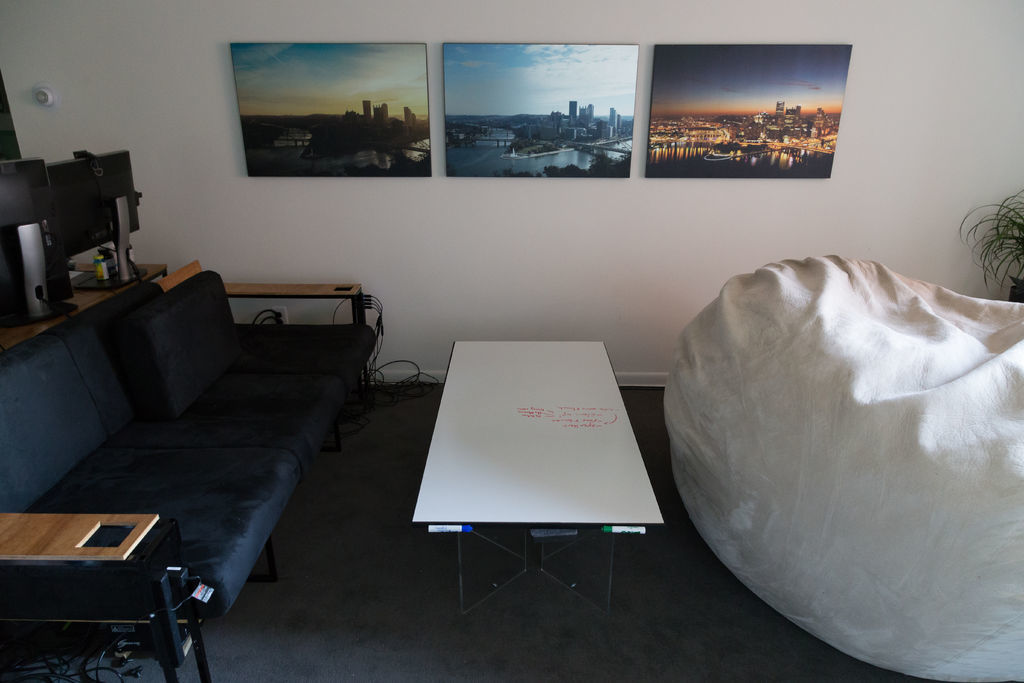
While we are programmers by trade, my roommate and I have spent the past three months creating Do-It-Yourself furniture, crafting 16 pieces in total. After planning, drafting, and modeling in SolidWorks, we were able to furnish our entire apartment.
Our works are of steel construction and are both unique and modern DIY projects. While the furniture was created for our own personal use, we wanted to share our unique designs and allow others the opportunity to enjoy the pieces as much as we do.
Here's how to build a "levitating" coffee table with acrylic legs, that doubles as a whiteboard! We made it at TechShop Pittsburgh, and a full BOM and assembly guide is available here:
Check us, and our projects, out at http://fabricate.io/ and at http://toddmedema.com/
Follow us on Facebook at https://www.facebook.com/fabricateIO
If you have any questions, please feel free to let us know!
Thanks,
Todd
Materials Required:
27.75"x55.75" Panel board (which is whiteboard coated)
27.75"x55.75"x0.5" Plywood
Black spray paint (highly recommended: black powder coat paint)
8 pieces of 24"x12" clear acrylic sheet (thickness can vary, but at least 0.2")
2x56" and 2x28" lengths of 3/4"x3/4"x1/8" steel angle (stock #A1343418)
Acetone and a rag to clean the steel
12 steel corner braces (other places will be cheaper - these match our laser cutter file holes)
Wood glue
At least 32 wood screws, #8 1/2"
Tools Needed:
Laser Cutter
Miter cold saw
Table saw
Drill press
Powder gun and oven for powder coating (or other painting method)
Prerequesites: You'll need to know how to...
Use a laser cutter
Drill holes with a drill press
Retain your appendages when using a cold saw and table saw
Not electrocute yourself with the powder gun (optional, but always helpful)
Step 1:
The first step in building your own levitating table is to cut and drill the acrylic. We attempted hand-cutting the acrylic for the legs, and swiftly realized there was no easy way to get a good finish. Enter the Trotec Speedy 300 laser cutter!
For each piece of acrylic, we cut out the attached vector design. The eight finished pieces were bolted together in pairs for extra strength, resulting in four stable legs.
The laser cutter settings we used were maximum frequency (5000Hz), speed 10, and power 50. You will have to adjust this depending on the acrylic thickness, color, laser cutter power, etc.
To ensure a nice finish, you'll want to make a few test cuts with your acrylic material to ensure everything looks as you expect. We also recommend placing some scrap plywood or other standoff between your acrylic part and the bottom grating, as this lets the smoke and vapors through and keeps the soot from adhering to the acrylic.
For those unfamiliar with laser cutters, we encourage them to visit TechShop and take the SBU, or refer to an online guide such as StumpChunkman's Instructable - both of these are excellent for teaching
the basics.
If you don't have access to a laser cutter, we'd recommend using a table saw to ensure a straight cut. Make sure you keep the protective plastic cover on during the cut to keep surface scratches to a minimum. It's also recommended to drill a very small pilot hole first and expand your bit size slowly, as acrylic can crack very easily when drilled. Step 2:
With the legs done, it's time to start cutting the steel trim! We were planning a huge furniture project with square steel channel and angle, so we had exactly the lengths we needed for this project. MetalsDepot is a great online supplier for this kind of steel channel, and Home Depot probably has some in supply if you want a local source.
Before doing anything with the steel, take some acetone and a rag and get scrubbin'! Clean steel accepts spray paint or powder coat much more readily, and the coating lasts for longer without flaking off. It takes some time to remove the black grease on the steel, but we found acetone (or alternatively mineral spirits) does a pretty good job cleaning it off. After a few minutes, the steel should look roughly the same, but your fingers shouldn't be dirtied when picking up the steel channel. For the absolute best coating, you can also sand-blast the metal (conveniently, TechShop also has a sand blaster)
Next, cut it down to the proper size - use a miter cold saw or a horizontal band saw to cut two 56" lengths and two 28" lengths. Then, set up the saw to cut at 45° and miter the edges so that they'll fit flush together when mounted to the table edges.
We'll need some drill holes to mount the steel angle to the plywood underside of the table. We suggest drilling in with a #18 bit, about 2.75" in from the very tip of the miter cut on each end for all pieces.
If you use a screw size other than #8, refer to this table to choose a good clearance hole size. Don't forget to debur the holes with a deburring tool for a nice finish!
Finally, it's time to make this steel look awesome. If you chose to use spray paint, take your steel outside and hang each piece with a coat hanger or other stiff wire using the holes you just drilled. Apply several light coats, waiting a few minutes between coats - once the steel is the color you want it, let it dry for another hour before handling it.
If you're looking for an even nicer finish, we highly recommend using a powder gun and powder coat paint. We used TechShop Pittsburgh's powder room and enormous annealing oven to do the job, but you can always get started with your own powder coating setup!
Step 3:
Now that we have the channel ready to mount, we need to cut the wood and wallboard down to proper table size.
This is relatively straightforward - if your pieces aren't the right size, just measure out a 22.75"x55.75" rectangle in both the plywood and the panel board and use a table or circular saw to cut it. The two pieces should line up together when laid flat.
Since the metal L channel isn't a perfect right angle - it has a bit of a curve on the inside - expect to need to sand down the bottom edges of the wood to get a tight fit. Doesn't need to be pretty, just needs to let the metal sit flush!
Step 4:
It's time for the final step: assembly.
Secure each set of two leg pieces together with a machine screw, and mount the angle brackets to the top using more machine screws as in the diagram.
Next, take the plywood and lay it flat. Position the steel channel around it, then secure the channel into place with #8 1/2" wood screws.
We'll need a bit of quick dimensioning to get the diagonal legs secured properly. Measure halfway between the inside faces of the long steel channel (13.25" from a side by our measurement), then mark in the same distance along that center line. Draw a line from each of the two closer corners to this intersection, on both sides.
Now, mount the acrylic legs with more #8 wood screws using these lines as handy 45° guides.
Then, all there's left to do is turn it over and attach the top surface. Apply some wood glue liberally to the top surface of the plywood, and then place the panel board on top with the white side facing up. Leave the glue to cure overnight, and then...
Step 5:
You've just made a professional-quality, levitating coffee table whiteboard! Our whiteboard table has seen many adventures during the last few months, as:
A dining surface
A table for card and board games (including some D&D)
A leg-rest for watching movies on the couch
And despite three months of abuse, it's maintained its quality and stability.
But most importantly, it's received a bit of an upgrade:
LED lighting
That's right - for about $20 (the lights plus a power supply), you can upgrade your fancy coffee table into an even fancier under-lit table. The "floating" effect is much more pronounced, and it's a great centerpiece during parties!
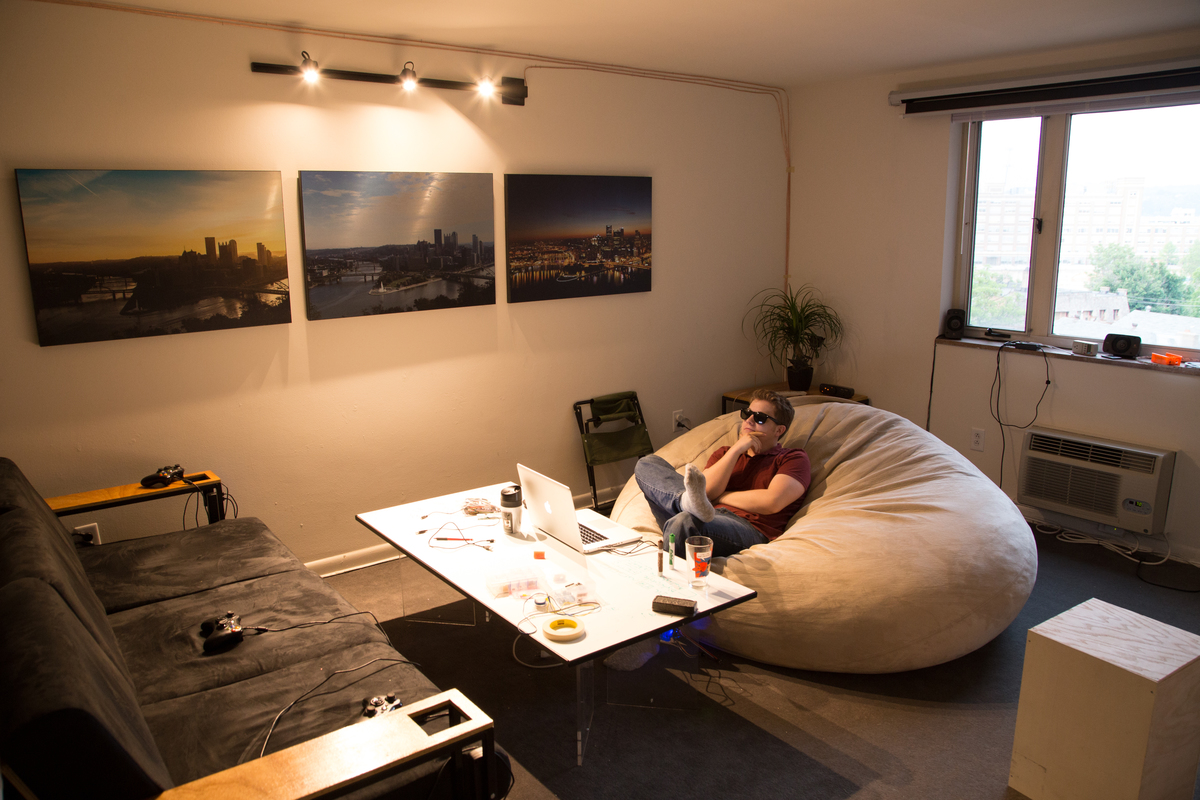
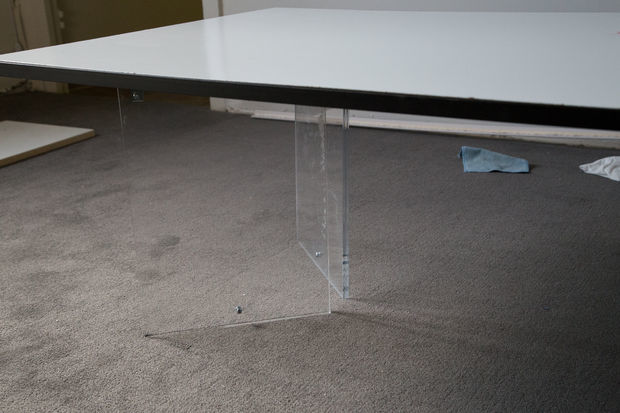
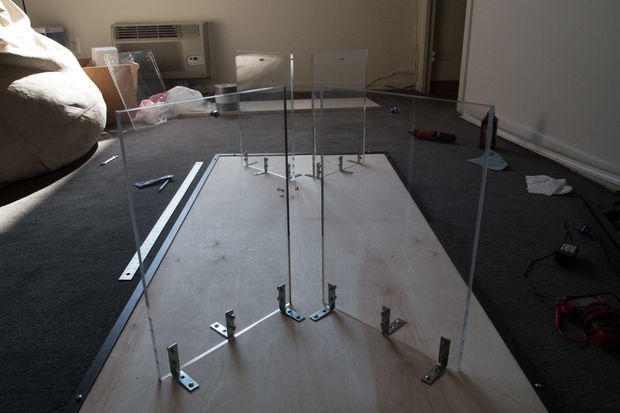
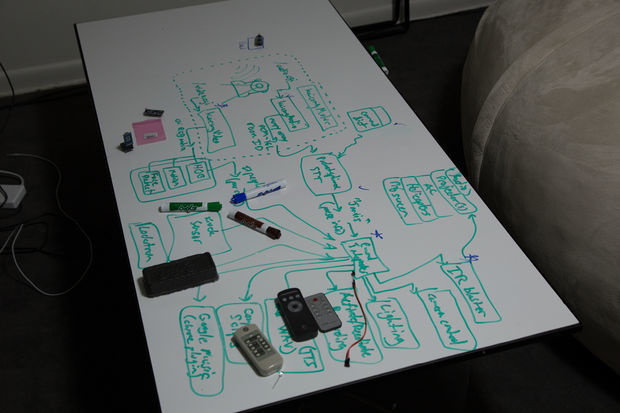
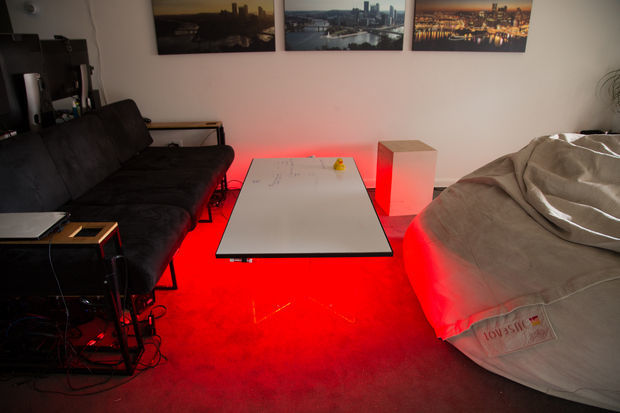
whiteboard top
Comments
Camp Grandma
Wed, 08/06/2014 - 07:10
Wow love it!
Very cool table. Hope you don't mind if I tuck your clever idea away for a future project. And whiteboard you can spill or write or draw on - brilliant!
booksnotbombs
Wed, 08/06/2014 - 07:14
Wow. So, this is FAR outside
Wow. So, this is FAR outside my beginner woodworking skill level since it's not even made of wood (well, the top might be--I didn't click through to the plans). However, I just wanted to say I LOVE it. Your living room looks so cool! It especially looks awesome with the lighting on. Also, that beanbag chair looks like the comfiest thing ever.